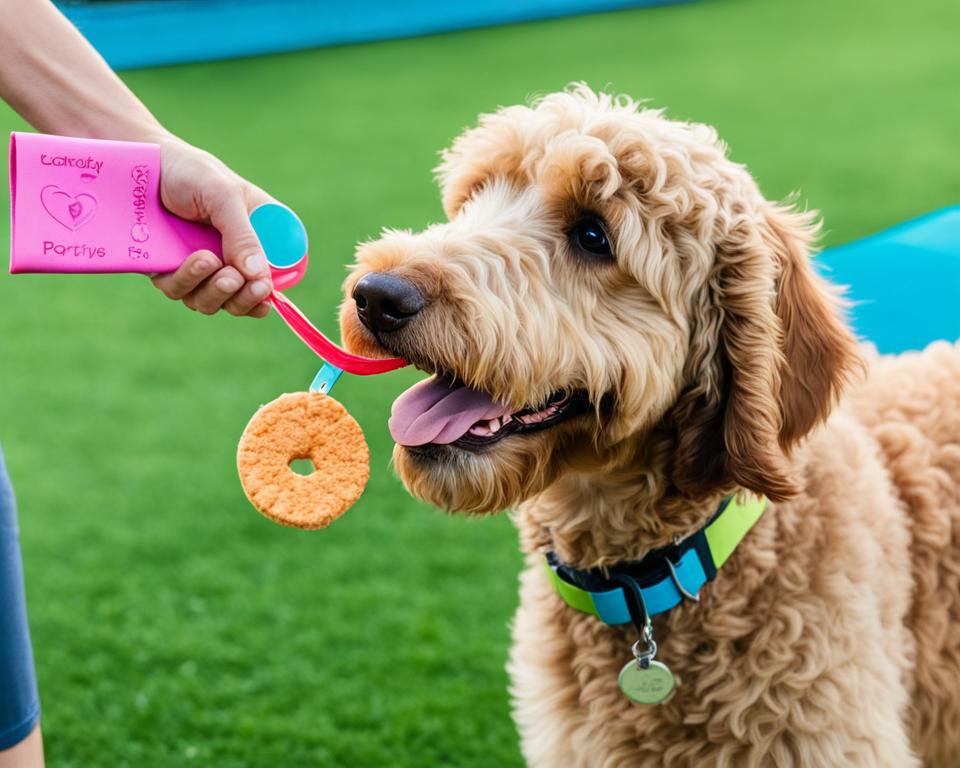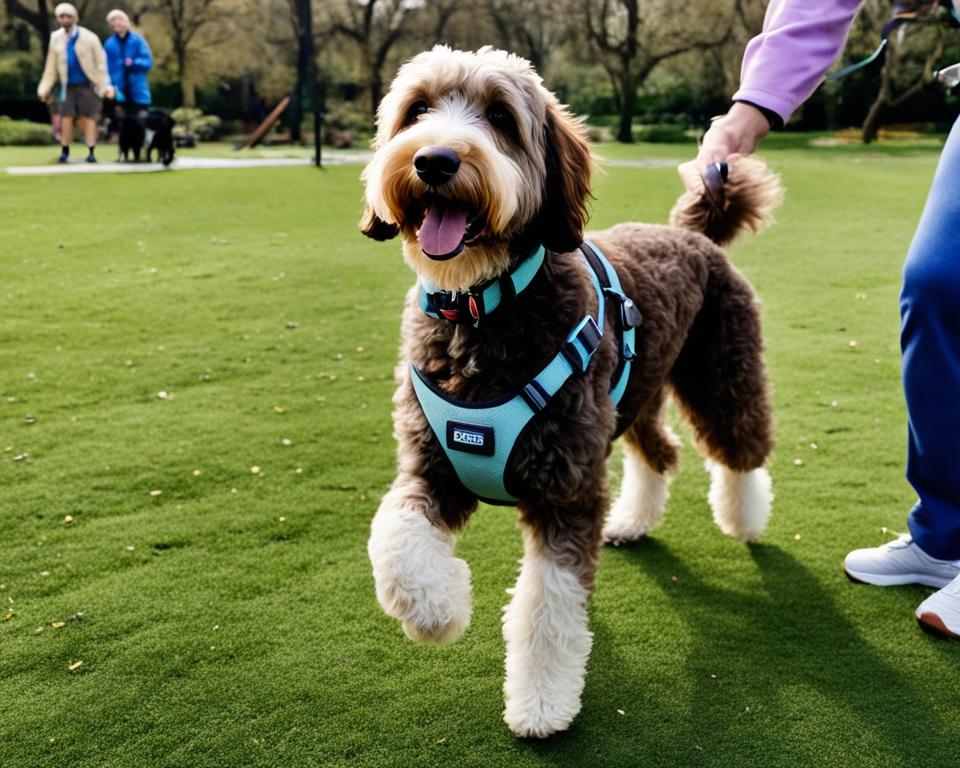Labradoodle socialization is an essential aspect of raising a well-behaved and confident furry companion. Socializing your Labradoodle involves exposing them to a variety of people, animals, and environments in a controlled and positive manner. By following expert socialization tips, you can ensure that your Labradoodle develops good social skills, reduces anxiety, and becomes a well-adjusted member of your family. These tips include starting socialization from a young age, using positive reinforcement, introducing them to different situations and environments, and addressing any behavioral issues that may arise.
Key Takeaways:
- Starting socialization early is crucial for Labradoodle puppies to develop good social skills.
- Positive reinforcement, such as treats and praise, is an effective training method for Labradoodles.
- Introduce your Labradoodle to different situations and environments to reduce anxiety and fear.
- Address any behavioral issues promptly and redirect their attention to more appropriate activities.
- Maintain consistency and continue training throughout your Labradoodle’s life to reinforce good behaviors.
Continue reading the article for detailed information on socializing your Labradoodle and ensuring they become a well-adjusted and well-behaved companion.
Starting Socialization Early
Early socialization plays a crucial role in the development of your Labradoodle puppy. It is recommended to start socializing your Labradoodle between the ages of 3 and 14 weeks when they are most receptive to new experiences and learning. By beginning socialization early, you can help your Labradoodle become a well-rounded and confident companion.
Introducing your Labradoodle to Friendly Faces
During the early socialization period, it is important to introduce your Labradoodle puppy to friendly people. This helps them build positive associations with humans and develop trust. Allow your puppy to interact with a variety of individuals, including men, women, and children, to ensure they become comfortable around different types of people.
Playdates with Other Dogs
Exposing your Labradoodle puppy to other dogs is an essential part of socialization. Arrange playdates with friendly, fully vaccinated dogs to provide your Labradoodle with opportunities for positive interactions and the development of appropriate social skills. Supervise these playdates to ensure a safe and controlled environment.
Exploring New Environments
Introduce your Labradoodle to different environments gradually. Start with familiarizing them with your home and backyard, then progress to short walks in quiet areas. Eventually, expose them to busier streets, parks, and other public spaces. This exposure helps them become comfortable in various settings and reduces the likelihood of fear or anxiety in unknown environments.
Positive Reinforcement and Rewards
During socialization sessions, use positive reinforcement methods to encourage good behavior. Reward your Labradoodle puppy with treats, praise, and playtime when they exhibit desirable social behaviors, such as approaching new people or other dogs calmly. This positive association helps them associate social experiences with positive outcomes and reinforces their confidence.
Socialization Checklist
Having a socialization checklist can be beneficial in ensuring you cover all essential aspects of your Labradoodle puppy’s socialization. Here is a sample checklist to guide you:
- Meeting people: Introduce your puppy to different types of individuals, including men, women, and children.
- Exposing to different environments: Gradually expose your puppy to various environments, such as parks, streets, and shops.
- Interacting with other animals: Arrange safe and supervised playdates with other friendly dogs to encourage positive social interactions.
- Handling and grooming: Get your puppy accustomed to being handled, groomed, and examined by touching their paws, ears, and teeth.
- Handling different objects: Introduce your puppy to various objects and noises they may encounter in daily life, such as vacuum cleaners, doorbells, and car rides.
| Socialization Checklist | Completed |
|---|---|
| Meeting people | |
| Exposing to different environments | |
| Interacting with other animals | |
| Handling and grooming | |
| Handling different objects |
Remember to tick off each item on the checklist as you successfully expose your Labradoodle puppy to different experiences. Regularly reviewing and updating the checklist will help you ensure comprehensive socialization for your furry friend.
Using Positive Reinforcement
Positive reinforcement is a highly effective training method for Labradoodles. It involves rewarding your dog with treats, praise, or playtime when they exhibit desired behavior. By using positive reinforcement, you can strengthen the bond between you and your Labradoodle and make the training process more enjoyable for them. Additionally, positive reinforcement encourages them to repeat the behaviors that you want to reinforce.
When training your Labradoodle, it is important to focus on positive reinforcement techniques. Rather than using punishment or harsh corrections, which can lead to fear and anxiety, positive reinforcement encourages your Labradoodle to engage in desired behaviors willingly. Whether you are teaching them basic commands, helping them learn new tricks, or addressing specific behavior issues, positive reinforcement can play a crucial role.
During training sessions, be sure to offer your Labradoodle rewards such as treats, verbal praise, and playtime whenever they perform the desired behavior. This positive reinforcement helps them understand that they are doing something right and motivates them to continue behaving in the same way.
Benefits of Positive Reinforcement
There are several benefits to using positive reinforcement when training your Labradoodle:
- Effective Learning: Positive reinforcement helps your Labradoodle associate desirable behavior with positive experiences, making them more likely to repeat those behaviors in the future.
- Stronger Bond: By using positive reinforcement, you build a stronger bond with your Labradoodle based on trust, respect, and mutual understanding.
- Motivation: Rewards such as treats and praise serve as motivation for your Labradoodle, encouraging them to actively participate in the training process.
- Reduced Stress: Positive reinforcement prevents the use of punitive measures, which can lead to stress and anxiety in dogs. This creates a safe and positive training environment for your Labradoodle.

Introducing Different Situations and Environments
To ensure proper socialization for your Labradoodle, it is crucial to introduce them to a variety of different situations and environments. By exposing them to different sights, sounds, and smells, you can help them become familiar and comfortable in various settings, reducing anxiety and fear. Here are some tips on how to accomplish this:
- Take them for walks in different locations: Bringing your Labradoodle to parks, busy streets, and quiet neighborhoods will expose them to different stimuli and help them feel at ease in various outdoor environments.
- Arrange playdates with other friendly dogs: This will give your Labradoodle the opportunity to socialize and interact with other dogs, improving their communication skills and overall social behavior.
- Enroll them in puppy classes: Puppy classes provide a structured environment for your Labradoodle to interact with other puppies and learn essential social skills under the supervision of experienced trainers.
- Introduce them to new people, children, and animals: Gradually expose your Labradoodle to different individuals and animals in a controlled and safe manner. This will help them develop positive associations with new faces and reduce the likelihood of fear or aggression.
By following these steps and introducing your Labradoodle to different situations and environments, you can contribute to their social development and ensure they grow into confident and well-adjusted companions.
| Benefits of Introducing Different Situations and Environments to Labradoodles: |
|---|
| 1. Reduces anxiety and fear |
| 2. Helps them become familiar with various settings |
| 3. Improves social skills and communication abilities |
| 4. Enhances overall social behavior |
Addressing Behavioral Issues
During the socialization process, it is important to address any behavioral issues that may arise in your Labradoodle. Common undesirable behaviors can include chewing on furniture, excessive barking, or jumping on people. To effectively address these issues, follow these Labradoodle training tips:
- Redirect attention: When your Labradoodle engages in unwanted behaviors, redirect their attention to more appropriate activities. Provide them with interactive toys, engage in playtime, or redirect their focus to training exercises.
- Positive reinforcement: Use positive reinforcement to reward desired behaviors. When your Labradoodle exhibits good behavior, provide treats, praise, or a favorite toy as a reward. This helps them associate positive experiences with appropriate behaviors.
- Consistency and patience: Be consistent in your training approach. Teach your Labradoodle that certain behaviors are not acceptable and consistently reinforce desired behaviors. Patience is key as it may take time for your Labradoodle to understand and modify their behavior.
- Professional help: If you are facing challenges in addressing behavioral issues, seek professional help from an experienced dog trainer or behaviorist. They can provide guidance tailored to your Labradoodle’s specific needs.
By addressing behavioral issues early on, you can ensure that your Labradoodle develops good manners and becomes a well-behaved and enjoyable companion.

| Undesirable Behavior | Addressing Techniques |
|---|---|
| Chewing on furniture | Provide appropriate chew toys and redirect their attention when they start chewing on furniture. Praise and reward them when they chew on the designated toys. |
| Excessive barking | Identify the triggers for barking and use positive reinforcement to redirect their behavior. Teach them commands like “quiet” and reward them when they stop barking on command. |
| Jumping on people | Ignore the jumping behavior and reward them when they greet people calmly with all four paws on the ground. Teach them an alternative greeting behavior, such as sitting or offering a paw. |
Consistency and Continued Training
Consistency is crucial when it comes to maintaining the socialization and training of your Labradoodle. Once you have established a socialization routine and trained your Labradoodle in basic commands, it’s important to continue reinforcing those behaviors through consistent training.
Set aside dedicated time every day for training sessions, making sure to incorporate training into your daily routine. Consistency is key to ensuring that your Labradoodle retains the learned behaviors and continues to progress in their training.
Use positive reinforcement as a powerful tool to reward good behavior. Whether it’s treats, praise, or playtime, positive reinforcement helps to reinforce the behaviors you want to see from your Labradoodle.
Remember to remain patient and persistent throughout the training process. Rome wasn’t built in a day, and neither is a well-behaved and socially adjusted Labradoodle. With consistent training and socialization techniques, your Labradoodle will continue to develop good social skills, behaviors, and overall obedience throughout their life.
FAQ
What is Labradoodle socialization?
Labradoodle socialization is the process of exposing your Labradoodle to a variety of people, animals, and environments in a controlled and positive manner. It helps them develop good social skills, reduce anxiety, and become a well-adjusted member of your family.
When should I start socializing my Labradoodle puppy?
It’s best to start socializing your Labradoodle puppy between the ages of 3 and 14 weeks, when they are most receptive to new experiences. Early socialization is crucial for their development.
How can I use positive reinforcement in Labradoodle training?
Positive reinforcement involves rewarding your Labradoodle with treats, praise, or playtime when they exhibit desired behavior. It strengthens the bond between you and your dog, makes training more enjoyable, and encourages them to repeat desired behaviors.
What are some different situations and environments I should introduce my Labradoodle to?
It’s important to expose your Labradoodle to various situations and environments, such as parks, busy streets, quiet neighborhoods, other dogs, children, and strangers. This helps them become familiar and comfortable in different settings.
What should I do if my Labradoodle displays behavioral issues during socialization?
If your Labradoodle displays undesirable behaviors, it’s important to redirect their attention to more appropriate activities and use positive reinforcement to reward desired behaviors. Seek professional help if needed, and address behavioral issues early on to ensure they become a well-behaved companion.
How can I maintain socialization and training for my Labradoodle?
Consistency is key. Set aside time every day for training sessions and incorporate training into your daily routine. Use positive reinforcement to reward good behavior, remain patient and persistent, and continue reinforcing desired behaviors throughout your Labradoodle’s life.

Leave a Reply